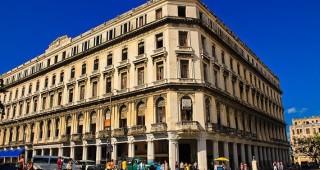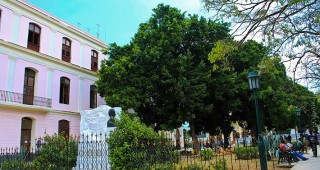Factoría Habana is an experimental center for present-day artistic creation. The institution, which is ascribed to the City Historian’s Office, seeks to become a bridge between Latin American and European art.
Factoría Habana is an experimental center for present-day artistic creation. The institution, which is ascribed to the City Historian’s Office, seeks to become a bridge between Latin American and European art.

 4
4The Lonja del Comercio, which first opened on March 1909, is angled obliquely to the square on its northern side. It was built in eclectic-style by the architectural firm of Purdy and Henderson as a c …
 EclecticOpen: 9am-5pm Mon-SunLamparilla, esq. a Oficios, Habana Vieja
EclecticOpen: 9am-5pm Mon-SunLamparilla, esq. a Oficios, Habana Vieja 
 4
4In 1689, Bishop Diego Evelino de Compostela founded San Ambrosio, an unpretentious school for boys, located on Tejadillo Street and adjacent to the Jesuit church under construction at the time. When t …
 BaroqueAdmission: FreeCuba e/ Chacón y Empedrado, Habana Vieja
BaroqueAdmission: FreeCuba e/ Chacón y Empedrado, Habana Vieja 
 5
5While the Floridita has its detractors, it is probably worth stopping in for a daiquiri just because it is there. It has certainly been around the block since it first opened its doors over 200 years …
 Traditional BarAdmission: FreeOpen: Open 11am-midnight daily
Traditional BarAdmission: FreeOpen: Open 11am-midnight daily $48 - $83ROOMS: 25Obispo #557, esq. a Monserrat, Habana Vieja
$48 - $83ROOMS: 25Obispo #557, esq. a Monserrat, Habana Vieja 
 4
4Owned by Julián de Zulueta, construction work began in 1890 according to the project designed by architect Pedro Tomé Veracruisse; however, still unfinished, it was sold to Andrés Gómez Mena, who comp …
 EclecticAdmission: n-aLimited by Neptuno, Monserrate, Obispo and Zulueta Streets, Habana Vieja
EclecticAdmission: n-aLimited by Neptuno, Monserrate, Obispo and Zulueta Streets, Habana Vieja 
 4
4This beautiful church and convent was built in Neo=\-Gothic style in 1874 and was a private girls’ school until 1961. The patio and chapel have beautiful wooden ceilings, notable stained-glass windows …
 OtherOpen: 8am-5pm Mon-Fri; 5-7pm Sat; 8-11am SunSan Lázaro #805 entre Oquendo y Lucena
OtherOpen: 8am-5pm Mon-Fri; 5-7pm Sat; 8-11am SunSan Lázaro #805 entre Oquendo y Lucena 
 4
4The idea of building this square emerged in the 1940s, when an international contest was organized to erect a monument to honor José Martí, Cuba’s National Hero. In 1943 the project was finally approv …
 ModernAdmission: CUC 3Open: 9am-4:30pm Mon-SatPaseo y Avenida de la Independencia (Boyeros)
ModernAdmission: CUC 3Open: 9am-4:30pm Mon-SatPaseo y Avenida de la Independencia (Boyeros) 
 4
4The América Theatre is one of the most interesting architectural works in Havana. It first opened on March 29, 1941 and is part of a large building complex located on one of Central Havana’s main comm …
 Art Deco
Art Deco 
 4
4Located on the north-east corner of the Plaza de la Catedral, this mid18th-century building is unusual in having three façades: the main one on Empedrado and the other two facing Mercaderes and the sq …

 4
4Tucked into the northwest corner of the plaza, the relatively austere gallery occupies three levels of a partially restored 18th-century townhouse mansion. It holds temporary exhibitions of both renow …

 4
4The mid-17-century plaza takes its name from the Iglesia del Santo Cristo del Buen Viaje. It was first known as Plaza Nueva taking the name of what is now known as Plaza Vieja. For a while it was know …